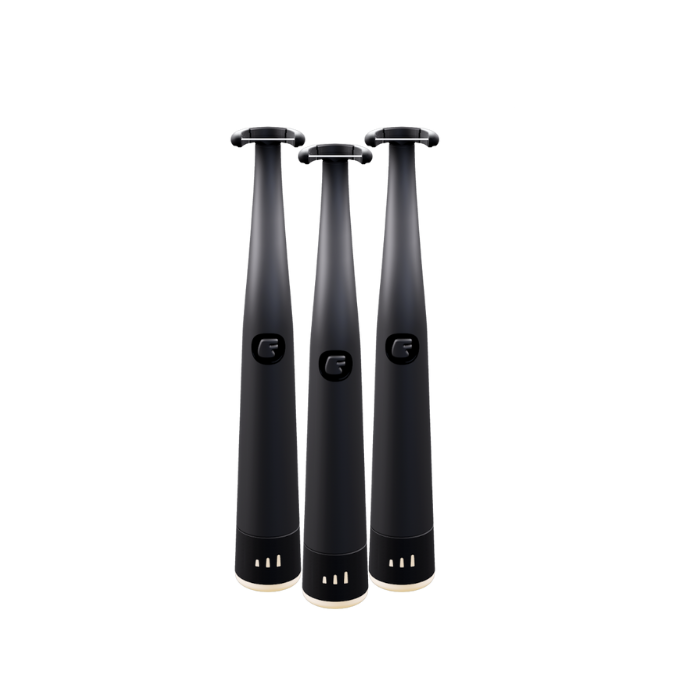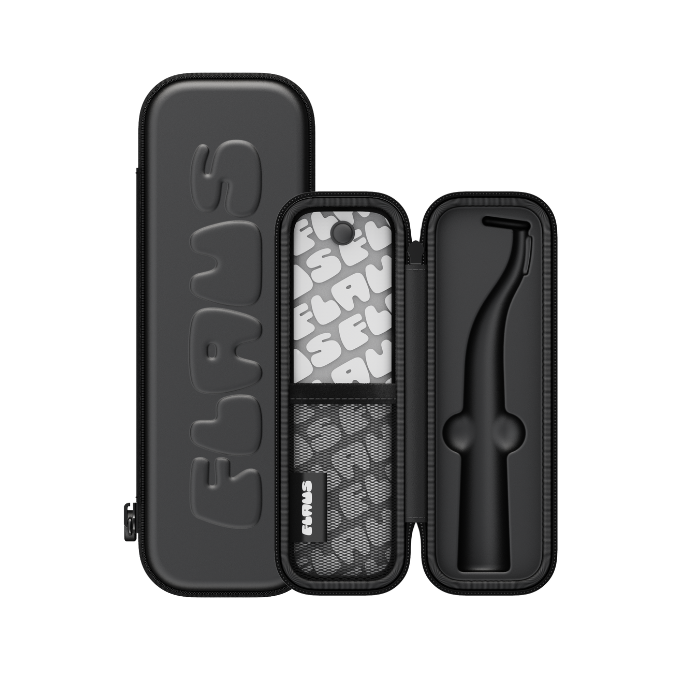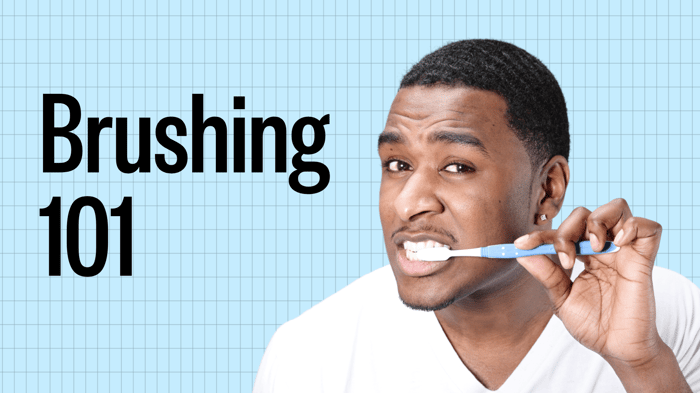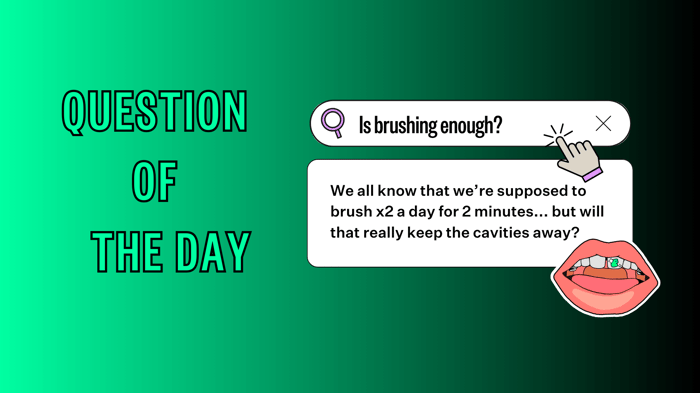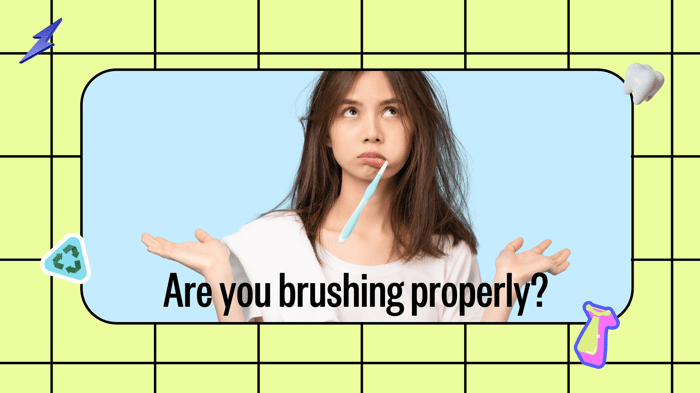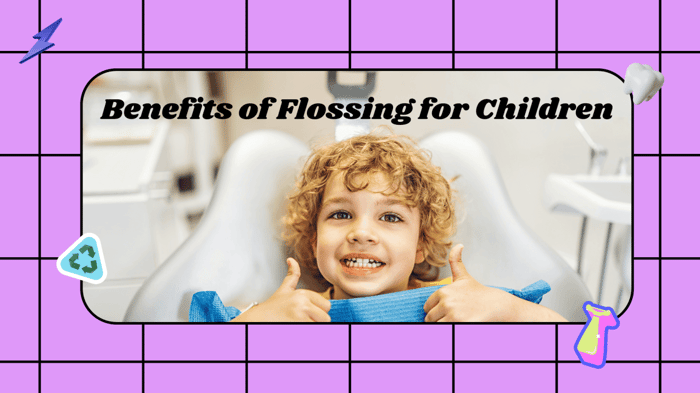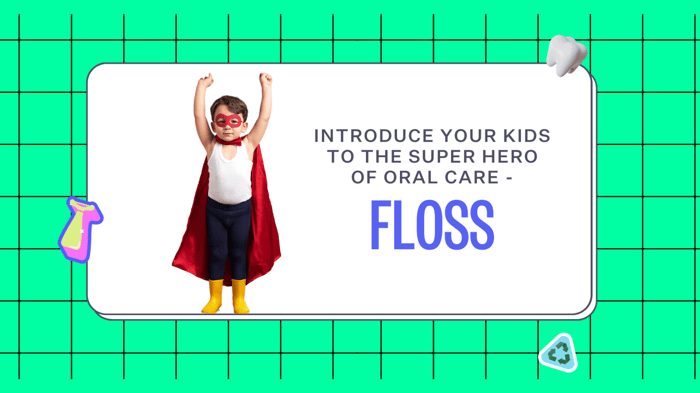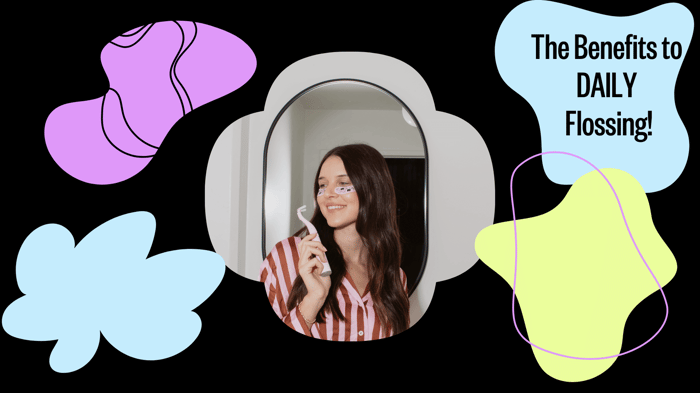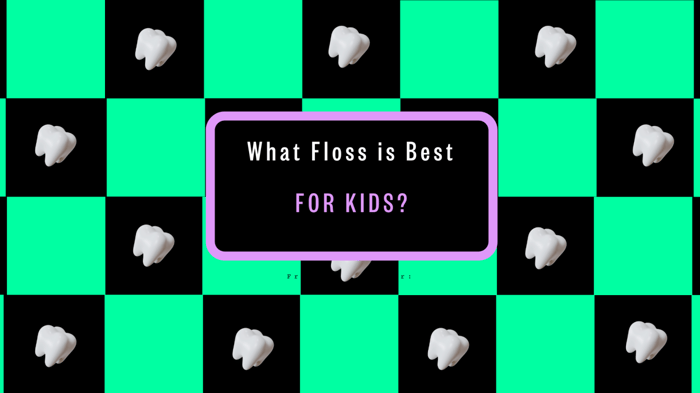It might come as a surprise but between 5% and 10% of adults in the U.S. have something in common - they all have a dental phobia! If you feel nervous before seeing the dentist or are scared to put on those sunglasses - you're not alone! Quite a few people react this way to dentists - now let's delve into understanding this fear a bit more deeply.
Coping with dental phobia can be challenging, but there are strategies that can help. These may include deep breathing exercises, seeking support from understanding dental professionals, gradually exposing yourself to dental environments, and considering sedation options. Always communicate openly with your dentist about your fears and concerns to find a solution that works for you.

Why Choose Flaus?
Flaus is a revolutionary flossing device designed to make flossing easy, effective, and comfortable. Its innovative design and gentle action make it perfect for those who dread traditional flossing methods. Here's how Flaus can help you:
- Gentle and Effective: Flaus uses sonic vibrations to clean between your teeth and along the gumline without causing discomfort.
- Easy to Use: The ergonomic handle and intuitive design make it simple, even for those with limited dexterity.
- Reduce Dental Visits: By maintaining excellent oral hygiene at home, you can minimize the need for invasive dental procedures.
Try Flaus Today
Identifying Dental Phobia
Dental phobia can be a significant roadblock to seeking oral healthcare. While it’s normal to feel slightly tense before visiting the dentist, for those with dental phobia, the distress is far more intense. It goes beyond ordinary nervousness and becomes an irrational fear.
Here is the tricky part: identifying dental phobia means understanding its symptoms. Panic attacks or severe anxiousness at just the idea of visiting the dentist are major indicators. These can manifest in physical forms too, such as sweating, increased heart rate, and feeling ill. Additionally, observe sleep patterns before a dental appointment; if they involve tossing and turning or persistent thoughts about the impending visit to the dentist, dental phobia may be playing into your fears.
A patient may also feel uneasy once they’re at the clinic, or even from just thinking about dental appointments in general - these feelings of discomfort are particularly common among individuals suffering from dental phobia.
Nearly 20% of individuals have reported significant anxiety symptoms due to fear of dentists or dental procedures, highlighting that those who experience these fears are not alone. Fears like these aren’t unfounded but avoiding necessary treatments due to dental phobia can harm overall health. Regular visits can prevent problems from developing and help maintain good oral health.
By learning whaant to look for and being mindful of one’s own responses to dental care appointments, individuals can take the first important steps toward maging their fears.
Understanding the signs is pivotal in addressing dental phobia effectively. Now, let's explore strategies and mechanisms that can aid in overcoming this overwhelming fear of oral care.
Coping Mechanisms for Dental Phobia
One of the most effective ways to deal with dental anxiety is through relaxation techniques. Deep breathing communicates to our bodies that we're not in any actual danger and can help reduce an elevated heart rate. It's our body’s natural way of signaling that "all is good, all is safe." Additionally, progressive muscle relaxation acts like a dimmer switch on a light—gradually taking away tension from our bodies, one part at a time. Visualization guides the mind away from the dental setting, helping individuals focus on calming mental images.
Communication is key in any relationship, including the one between patients and their dentists. Openly discussing fears, concerns, and experiences with the dentist can alleviate some of the anxiety linked to dental appointments. When mutual trust is established through these dialogues, people feel more understood and in control during treatments.
Let's face it—silence is scary. Having a dental procedure done isn't the most comforting activity for some of us. That's where distraction techniques come in! Using headphones to listen to music or podcasts can be incredibly helpful during dental procedures. Some patients prefer reading a favorite book or squeezing a stress ball to take their minds off the treatment. These activities redirect focus from the dental environment, making it easier for people to push out negative thoughts that exacerbate anxiety.
Think of this like going to a movie theater when you've watched something frightening before—music and books work the same way; they provide comfort by taking our minds away from what’s causing our fear.
These coping mechanisms might seem small, but combined they make a big difference in transforming your experience at the dentist—turning it from one filled with fear and anxiety to one that is much more manageable and less stressful. By focusing on these strategies used during your previous visit, you'll find that handling your dental fears becomes easier over time. It's about learning to use these tools at your disposal to help you maintain control over your anxiety and take steps toward overcoming your dental phobia.
Mastering strategies to cope with dental anxiety is an essential step in achieving a stress-free dental experience. Now, let's delve into another effective method— the use of sedation in dentistry.
Use of Sedation in Dentistry
Dental anxiety can be incredibly overwhelming, making it harder for individuals to seek the dental care they need. Sedation dentistry offers a range of options, from minimal sedation to general anesthesia, providing a way for patients to relax and receive necessary procedures without added stress.
Types of Sedation
There are several types of sedation used in dentistry, each serving a specific purpose:
- Minimal Sedation: Leaves you awake but relaxed. Useful for patients who feel a bit anxious about dental visits.
- Moderate Sedation: May cause slurred speech and limited memory of the procedure, while still conscious.
- Deep Sedation: Leaves you on the edge of consciousness but easily awakened.
- General Anesthesia: Puts you in a state of complete unconsciousness, generally used for complex procedures or individuals with extreme dental phobia.
The choice of sedation depends on the individual's level of anxiety and the complexity of the procedure being carried out.
Benefits of Sedation Dentistry
Sedation dentistry offers various benefits that significantly assist patients who experience extreme fear and nervousness:
- Reduced Anxiety: It helps lower anxiety levels and promotes a sense of calmness.
- Pain Management: Ensures the comfort of the patient by managing pain during treatment.
- Easier Procedures: Allows the dentist to work more effectively as they have a relaxed patient who will not make sudden movements or experience discomfort during prolonged treatment.
- Treating Severe Phobias or Gag Reflexes: Eases dental treatments for patients with severe phobias or highly sensitive gag reflexes.
- Time Efficiency: Allows multiple procedures to be carried out in fewer sessions, enhancing time efficiency.
Understanding Risks
Despite its advantages, sedation dentistry also comes with risks that are primarily dependent on the type and depth of sedation utilized.
Even minimal oral sedatives come with possible side effects such as dizziness, headache, drowsiness, or nausea. For this reason, prior consultation with a dentist is imperative.
Each individual's needs differ when it comes to overcoming dental phobias and anxieties. As such, understanding the varying types and applications of sedation dentistry will help individuals make informed decisions—ultimately aiding in shifting away from unmanageable fear toward comprehensive dental care.
Behavioral Techniques for Dental Anxiety
When it comes to coping with dental phobia, behavioral techniques offer a different approach to combating anxiety compared to sedation. Cognitive-behavioral therapy (CBT) emphasizes changing negative patterns of thought and behavior which may contribute to the fear of dental visits. This type of therapy helps individuals identify how their thoughts and feelings manage to get them fearful, then guides them in changing these reactions.
Imagine recognizing what makes you scared and realizing that you can change these reactions - that's exactly what CBT aims to achieve. By learning new ways to manage negative feelings and thoughts about dental visits, individuals can develop strategies to confront their fears and slowly build confidence in their ability to manage their anxiety surrounding dental care.
Another very effective technique for managing dental anxiety is gradual exposure therapy. Just like the name suggests, this involves slowly and repeatedly exposing individuals to their fears in a controlled setting until the anxiety becomes more manageable. The aim is not to overwhelm but rather help patients gradually become accustomed to the experiences or situations that trigger their anxiety.
Imagine being gradually exposed to your fears until you realize they're not as bad as you thought - that's what this kind of therapy allows individuals to experience. For someone who fears stepping into the dentist's office even for a routine check-up, gradual exposure therapy could involve spending time at the clinic without any procedures being done, steadily moving towards more substantial interactions over time.
Both of these behavioral techniques are very beneficial for addressing dental anxiety and phobia, offering patients methods for long-term management that focus on altering thought patterns, managing emotions, and building confidence around dental visits.
In developing comprehensive strategies for creating a calming environment at the dentist's office, understanding these behavioral techniques can lay the groundwork for designing effective interventions that assist patients in navigating their fears and anxieties.

Tips for Creating a Calm Dental Environment
Stepping into a dental office can stir feelings of unease in many individuals. However, designing a calming environment within the clinic can significantly reduce patient anxiety and enhance their overall experience.
When it comes to design, soft, muted colors can have a soothing effect on anxious patients. Consider incorporating pastel shades like light blue or pale green in the decor. These colors are often linked with calmness and relaxation, easing the nerves of patients as they wait.
Comfortable waiting areas are another essential component in creating a tranquil dental environment. Providing ample seating with plush, cozy chairs and sofas, along with elements of nature like indoor plants, can bring serenity to the setting. Reading materials and interactive displays offer mental distractions while waiting, further soothing anxious minds.
In addition, playing calming music in the waiting room can significantly enhance the ambiance of your practice. Soft instrumental music or sounds of nature create a relaxing setting for patients, diverting their attention from nervous thoughts and inducing a sense of calmness.
Moreover, providing calming videos or interactive displays in the waiting area effectively engages patients and diverts their attention from anxiety-provoking thoughts. These distractions help reduce patients' stress levels while awaiting their appointment by allowing them to focus on something pleasant and enjoyable.
By paying attention to details like color schemes, comfortable waiting areas, soothing music, and engaging distractions, dental practices can effectively transform their environments to be more welcoming and tranquil for anxious patients.
When designing your dental space, consider how these elements can help create an environment that promotes relaxation and comfort—showing your patients that you are attentive to every aspect of their experience.
Implementing these strategies is crucial in creating an environment that puts patients at ease and contributes to their overall well-being. Now let's delve into techniques that aid in comprehending phobias associated with dental visits.
Phobia Research and Overcoming Fear
Dental phobia, also known as odontophobia, affects millions worldwide. It's not just a minor apprehension; it can cause intense anxiety or even panic attacks at the thought of visiting the dentist or undergoing dental procedures. As such, researchers have been delving deeper into understanding why this phobia occurs and what can be done to help people overcome it.
The Reality of Dental Phobia
For many individuals, dental phobia may stem from distressing past experiences, a fear of pain, concerns about loss of control, or other factors rooted in early life experiences or trauma. More severe cases can lead to avoidance of routine dental visits for years. It's important to realize that dental phobia is more than just dislike or uneasiness; it is an actual anxiety disorder that requires appropriate care and understanding.
Research has shown that cognitive restructuring, which involves changing negative thought patterns into constructive ones, can provide significant relief. Therapists utilize various techniques, including gradual exposure therapy, relaxation methods, and mindfulness practices to assist patients in coping with their fears.
Promising Treatments
In recent years, researchers have made significant strides in identifying effective treatments for dental phobia. One notable innovation is the use of immersive virtual reality (VR) environments to desensitize patients to the sights and sounds typically associated with dental offices. This approach has shown considerable promise in reducing anxiety levels among individuals with severe dental phobia.
Imagine stepping into a virtual world where you're in control throughout a virtual visit to the dentist's office and slowly getting accustomed to the sights and sounds that trigger your discomfort in real life.
Emphasizing these advancements allows individuals struggling with dental phobia to find hope and reassurance in therapies specifically designed to address their fears. Having access to such information might empower them in seeking out solutions that work best for their unique needs.
Breaking Free from Dental Phobia
Dental phobia can make the thought of a routine dental visit utterly overwhelming and frightening. It's crucial to acknowledge these fears to confront them effectively. Many people experience dental anxiety, so seeking help from a psychologist or therapist who specializes in dental fears can be an excellent first step. A mental health professional can guide you through effective strategies to manage your anxiety and prepare you for the dental experience.
For others, joining support groups or online communities dedicated to overcoming dental phobia may provide comfort and empowerment. Engaging with others who share similar apprehensions can offer understanding, empathy, and valuable coping mechanisms for addressing the fear of visiting the dentist. This type of community support often serves as a safe space for individuals to express their concerns while receiving encouragement and guidance from others striving to overcome dental anxiety.
Gradually working toward conquering dental fears requires patience and self-compassion. It may involve small steps such as visiting the dental office without an appointment or having a consultation with a dentist to discuss your anxieties before scheduling any procedures. Progress doesn't happen overnight; take your time, celebrate small victories, and allow yourself the space to work through your fears at your own pace. Our website acts as a valuable resource for those seeking to break free from dental phobia, offering guidance and support tailored to individuals navigating this challenging journey.
This journey might include reading articles or success stories shared by others who have successfully addressed their dental anxiety, finding reassurance and practical tips they can follow. The platform of shared experiences often alleviates feelings of isolation and provides useful recommendations based on real-world experiences.
Seeking support and encouragement through these strategies will empower individuals living with dental phobia to cultivate resilience as they navigate their journey towards overcoming their fears.
Acknowledging your fears, seeking professional assistance, fostering strong connections within support communities, and adopting a gradual approach are foundational steps in confronting dental phobia head-on. These methodologies substantially contribute to realizing the goal of breaking free from persistent dental-related anxieties.
If you're struggling with dental phobia, know that it's okay to seek help and support. You deserve a healthy smile and peace of mind. Don't hesitate; take the first step towards overcoming your fears today!
Proactive Habits
Being proactive in your oral care habits can also help to ease your dental phobia. When you know you've been keeping up with your oral hygiene - you may have less anxiety of the results of the trip. Using an electric flosser and electric toothbrush can help you habit build and help make your routine easier, meaning you'll be more likely to stick to it!
For those of us who are negligent flossers - an electric flosser might help you develop a habit! A great alternative to traditional flossing are electric flossers, like Flaus.
Electric flossers are a great way to maintain good oral hygiene, and Flaus is a good option for those looking for a flossing method easily allows you to reach your back molars and helps to speed up your routine. Here are some reasons why using an electric flosser is a great alternative to traditional flossing:
- Easy Reach: They can reach tight spaces and molars easily due to the ergonomic handle
- Easy to use: Electric flossers are easy to use and require less manual dexterity than traditional flossing
- Comfortable: They can also be less messy and more comfortable to use than string floss, as you don't have to put your fingers in your mouth
- Encourages good habits: Many people find electric flossers more enjoyable to use than traditional floss, which can encourage them to floss more regularly
- Eco-friendly: Flaus is the world's first eco-friendly electric flosser, which can reduce waste and help protect the environment. Flaus uses 90% less floss than traditional flossing and offers a Flaus head recycling program to ensure that the floss heads are properly recycled at a dedicated oral care recycling facility.
Some of the features that Flaus has include:
- Sonic vibrations: At 18,000 sonic vibrations/min, Flaus moves quickly and easily between tight teeth to massage gums and remove plaque and debris from tight spaces your toothbrush can’t reach.
- Ergonomic Soft Touch Handle: With a design that feels as familiar as your favorite electric toothbrush, Flaus′ premium, ergonomic soft-touch handle gives you full control over hard-to-reach places while keeping your fingers (and the 10 million bacteria that live on them) out of your mouth.
- Waterproof: Whether you are flossing on the go or multi-tasking in the shower, Flaus is waterproof and has you covered.
- High Performing Floss Heads: Floss heads are fitted with high performing glide floss strong enough for the tightest of teeth, made with recyclable plastic and use 30% less plastic than traditional floss picks. You can also recycle your Flaus heads through a Floss Head recycling program where the floss heads are sent to be recycled in a dedicated oral care recycling facility.
- Two Month Battery Life: The rechargeable flosser has a two month battery life and comes with a charging base and USB cable to boot.
- Dentist Designed and Recommended: Flaus was designed with dental experts from day one to ensure the very best clean.
Overall, electric flossers, like Flaus, can be a great way to maintain good oral hygiene and develop / encourage good habits. They are effective, easy to use, and eco-friendly, making them a good option for those looking for an alternative to traditional flossing.
What are the common symptoms of dental phobia?
Common symptoms of dental phobia include feelings of intense fear or anxiety before and during dental appointments, difficulty sleeping the night before a visit to the dentist, avoidance of dental care, panic attacks, and even physical symptoms such as racing heartbeat, trembling, or sweating. According to a study conducted in 2022 by the American Dental Association, 61% of adults experience dental anxiety to some degree, with 4% having severe dental phobia.
Can dental phobia be overcome completely, or is it a lifelong struggle?
Dental phobia can be overcome completely with the right tools and support. While it may require time and effort, countless individuals have successfully conquered their fear of the dentist. According to a study conducted by the University of Gothenburg, 79% of participants who underwent cognitive behavioral therapy for dental phobia reported significant improvement in their fear levels. With proper guidance and an understanding dental team, dental phobia does not have to be a lifelong struggle.
Are there any support groups or resources available for individuals dealing with dental phobia?
Yes, there are numerous support groups and resources available for individuals dealing with dental phobia. These include online forums, counseling services specializing in dental phobia, and support groups where people can share their experiences and offer mutual support. According to a survey conducted by the Dental Anxiety Association, 78% of dental phobia sufferers found support groups helpful in managing their fear and anxiety. Additionally, there are self-help books and apps that provide techniques and strategies for coping with dental phobia.
Are there any specific techniques or strategies that can help in coping with dental phobia?
Yes, there are specific techniques and strategies that can help in coping with dental phobia. One effective technique is called cognitive behavioral therapy (CBT), which helps individuals identify and change negative thought patterns associated with dental visits. Relaxation techniques such as deep breathing exercises or listening to calming music can also reduce anxiety. Additionally, the use of sedatives like nitrous oxide or conscious sedation can be beneficial for patients with severe dental phobia, with studies showing a significant decrease in anxiety levels (source: Journal of Dental Anxiety and Phobia, 2023).
How can dental professionals accommodate patients with extreme dental phobia during treatments?
Dental professionals can accommodate patients with extreme dental phobia during treatments by implementing strategies such as creating a calm and relaxing environment, providing distractions like music or movies, offering sedation options, and using gentle techniques. According to a study published in the Journal of Dental Education, these tactics have been found effective in reducing anxiety levels among patients with dental phobia, leading to improved treatment outcomes and increased patient satisfaction.








